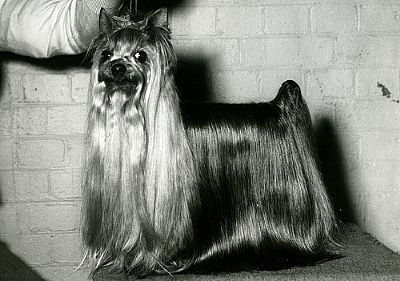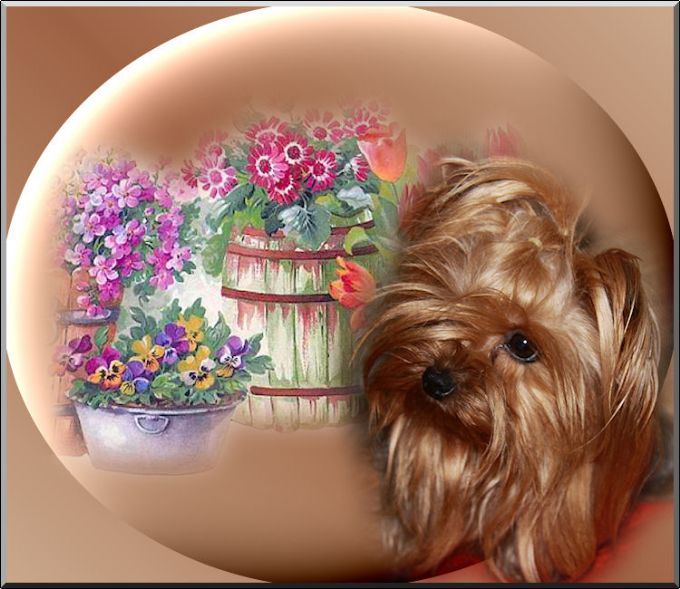|
PURE BREDS AREN'T FOR THE ELITE
they're for the ethical and responsible...
**
Below - Eng Ch Blairsville Royal Seal - 'Tosha'

**
Regarded by many as among the best Yorkshire Terriers, if not THE best,
ever bred. To me, UK Ch Blairsville Royal Seal represents the epitome
of what the breed is all about.
Royal Seal died in 1988 aged 15 years.
During his show career Tosha won 50 CCs,
all under different judges. He was 12 times Best In Show at all breed CH
shows, and 16 times Reserve Best In Show. He took 33 Group wins, and
went Reserve Best In Show at Cruft's in 1978, just as his dam had done
before him. Tosha was Top Dog, all breeds, for two consecutive years.
He became the sire of many prolific Champions and still features in the
pedigree of many of today's Yorkies.
Below is the Breed Standard for the Yorkshire Terrier
as currently adopted in Australia.

| Group: |
Group 1 (Toys) |
| History: |
|
| General Appearance: |
Long coated, coat hanging quite straight and evenly down each side, a parting extending from nose to end of tail. Very compact and neat, carriage very upright conveying an important air. General outline conveying impression of vigorous and well-proportioned body. |
| Characteristics: |
Alert, intelligent toy terrier. |
| Temperament: |
Spirited with even disposition. |
| Head And Skull: |
Rather small and flat, not too prominent or round in skull, nor too long in muzzle, black nose. |
| Eyes: |
Medium, dark, sparkling, with sharp intelligent expression and placed to look directly forward. Not prominent. Edge of eyelids dark. |
| Ears: |
Small, V-shaped, carried erect, not too far apart, covered with short hair, colour very deep, rich tan. |
| Mouth: |
Perfect, regular and complete scissor bite, i.e. the upper teeth closely overlapping the lower teeth and set square to the jaws. Teeth well placed with even jaws. |
| Neck: |
Good reach. |
| Forequarters: |
Well laid shoulders, legs straight, well covered with hair of rich golden tan a few shades lighter at ends than at roots, not extending higher on forelegs than elbow. |
| Body: |
Compact with moderate spring of rib, good loin. Level back. |
| Hindquarters: |
Legs quite straight when viewed from behind, moderate turn of stifle. Well covered with hair of rich golden tan a few shades lighter at ends than at roots, not extending higher on hindlegs than stifle. |
| Feet: |
Round; nails black. |
| Tail: |
Preferably docked to medium length with plenty of hair, darker blue in colour than rest of body, especially at the end of tail. Carried a little higher than level of back. |
| Gait/Movement: |
Free with drive; straight action front and behind, retaining level topline. |
| Coat: |
Hair on body moderately long, perfectly straight (not wavy), glossy; fine silky texture, not woolly. Fall on head long, rich golden tan, deeper in colour at sides of head, about ear roots and on muzzle where it should be very long. Tan on head not to extend on to neck, nor must any sooty or dark hair intermingle with any of tan. |
| Colour: |
Dark steel blue (not silver blue), extending from occiput to root of tail, never mingled with fawn, bronze or dark hairs. Hair on chest rich, bright tan. All tan hair darker at the roots than in middle, shading to still lighter at tips. |
| Sizes: |
Weight: up to 3.2 kg (7lbs) |
| Faults: |
Any departure from the foregoing points should be considered a fault and the seriousness with which the fault should be regarded should be in exact proportion to its degree and its effect upon the health and welfare of the dog. |
| Notes: |
Male animals should have two apparently normal testicles fully descended into the scrotum. |
http://www.k9web.com/dog-faqs/breeds/yorkies.html
http://www.thedogplace.org/SHOWDOG/Preserving-Breed-Standards_Gammill-122.asp
**
What is 'Excellence' in a Breed?
Is it simply conforming externally to the breed standard?
Is it being able to show that it is a real working dog capable of endurance
at
its job?
Is it being both beautifully structured and healthy?
Is it being beautifully structured, healthy and temperamentally sound?
Is it being beautifully structured, healthy, temperamentally sound, and able
to
endure doing its job?
If you breed a dog or bitch who is a splendid match to the breed standard,
but
is so dysplastic at age 3 that it is crippled, is that excellence?
If you breed a dog or bitch who is a splendid match to the breed standard,
but
is diseased and dies at age 5, is that excellence?
If you breed a dog or bitch who is a spendid match to the breed standard,
but is
so foul tempered that it is impossible to live with, is that excellence?
What if you have a dog or bitch who is a splendid match to the breed
standard
structurally and movement-wise, is a hard-working animal, has a lovely
temperament, but has too much white in its coat? or has improper coat? or
has
some other cosmetic fault? Is that excellence?
How can one determine excellence simply by contests in the breed ring, in
the
agility ring, or obedience ring? Do you not really need to
look
at the life-long aspects of the dog or bitch from youth to senescence to
determine whether you really had an "excellent" example of the breed? [And
by
then, might you have missed your opportunity to breed the animal if you
waited
to see how everything fell out over time?]
How does one achieve excellence in breeding?
PRESERVING BREED STANDARDS
E. Katie Gammill, AKC Judge/Exhibition Editor, TheDogPlace.org
It seems that a lot of judges and breeders are ignoring some key points in the breed standards. The result is a shift towards cookie cutter dogs and generic movement.
 When breed standards were initially written there was a point system that prioritized attributes for individual breeds. In most breeds, this valuable tool was removed. That left judging the breed up to the discerning “eye” of a breeder or judge which in truth, allowed importance to be placed upon virtues which the Breed Standard never intended. When breed standards were initially written there was a point system that prioritized attributes for individual breeds. In most breeds, this valuable tool was removed. That left judging the breed up to the discerning “eye” of a breeder or judge which in truth, allowed importance to be placed upon virtues which the Breed Standard never intended.
Some say the era of large kennels has passed, however, there ARE breeders today breeding quality, correct dogs with a minimum of well chosen individuals in their possession. These breeders continue to adhere to the breed standard and are continuously beaten in the ring by judges who, in their short span in the sport, have never seen the greats. Or if they have seen them, they don’t have the courage to pull one forward when it enters their ring.
With wonderful educational opportunities, access to parent club breed standards and assistance for new judges to move forward, our sport is regressing at an alarming rate. Why? That is something we must all address and decide for ourselves. Do we want to move forward in the sport of dogs and leave something for future generations, or do we simply want to have a fun day with our dog?
Demanding judges to be educated based on pieces of the breed standard hasn’t worked. Somewhere along the way, this “breed seminar” and “judges education” idea took on a life of its own. Despite AKC efforts to improve judging, it seems each step added another obstacle. Someone asked Dale Carnegie what it took to be successful. He answered.” I don’t know how to tell you to become successful. I can tell you how to fail. Try to please everyone."
Is that what we’re doing in both breeding and judging seminars? Perhaps we need to study and apply the entire breed standard!
Why, if there is only one breed standard, does it take 15 mentors to teach new judges? Are we teaching to the standard or are we simply teaching “opinions?”
|
Why are judges shown only outstanding individuals at breed seminars? Being involved in dogs, horses, goats, rabbits, and various other critters, I swear one learns more from the bad ones. How can one compare virtues unless they see them alongside breed faults? The easiest way to learn structure is a direct comparison of “bad” and good, yet rarely is structure considered during judging seminars. It is assumed that by the time one reaches that level, judges know all about structure but if that’s the case, why are they there?
Judges attempt to follow a written breed standard. So why remove the point systems from the breed standards? Why, to make it easier for judges. Why do we have judge's education? Because exhibitors and breeders want judges to become better educated and thus make better choices. Despite breed seminars and the AKC Institutes and materials, do we have better judges? If we no longer judge breeding stock by the breed standard, what is the point?
How does one learn to judge a dog when several dogs are shown as examples and the student is told on the first dog “this is the desired eye, the second dog has the preferred head, the third dog offers coat characteristics, the fourth dog has the desired proper foot, and the fifth dog offers ear set, and so on? THEN a judge is expected to evaluate the dog in its entirety? This is what it means to “have an eye” for a dog. It isn’t something one can grow. It is the ability to absorb the different virtues, then go into the ring and select the animal based on symmetry and let it “fill the eye.” while prioritizing the breed standard’s listed virtues in order or priority.
When the eye is drawn to any specific part of a dog, be it rear, head, ears, coat, or foot, usually it is because it is exaggerated and therefore, incorrect. Examples are floppy flews on Great Danes, dogs with over angulated rears, straight fronts, and overdone coats. Yet, often this is the very thing the piece-judge “beads in on” due to breed seminar education. The goal is to find an animal that reflects a balance of type and soundness.
Is it any wonder breeds are in a constant state of flux regarding “type”? Of course, we can be generous and say breed standards are open to the interpretation of each individual, but the fact remains, if breeders don’t breed to a specific blueprint, what is the point of breeding at all? Have we forgotten that the initial reason for our sport was to gather and select dogs that most represented our written breed standards?
Fact: “Type change is when an obvious fault becomes so concentrated it eventually appears to be accepted as a virtue”. Rather than taking up the challenge of breeding (or judging) to the breed standard, it’s easier to flood the ring with the latest fad, thus making the “correct to the breed standard” dog look out of place.
|
“I can do what I want” seems to take precedence in today's world but when dogs are judged in pieces and the breed standard places no emphasis, people will breed for what wins rather than what is correct. That is, until the next big thing surfaces. Changing the rules to fit the game has not improved our sport.
|


![]()
![]()
![]()
![]()
![]()
![]()

